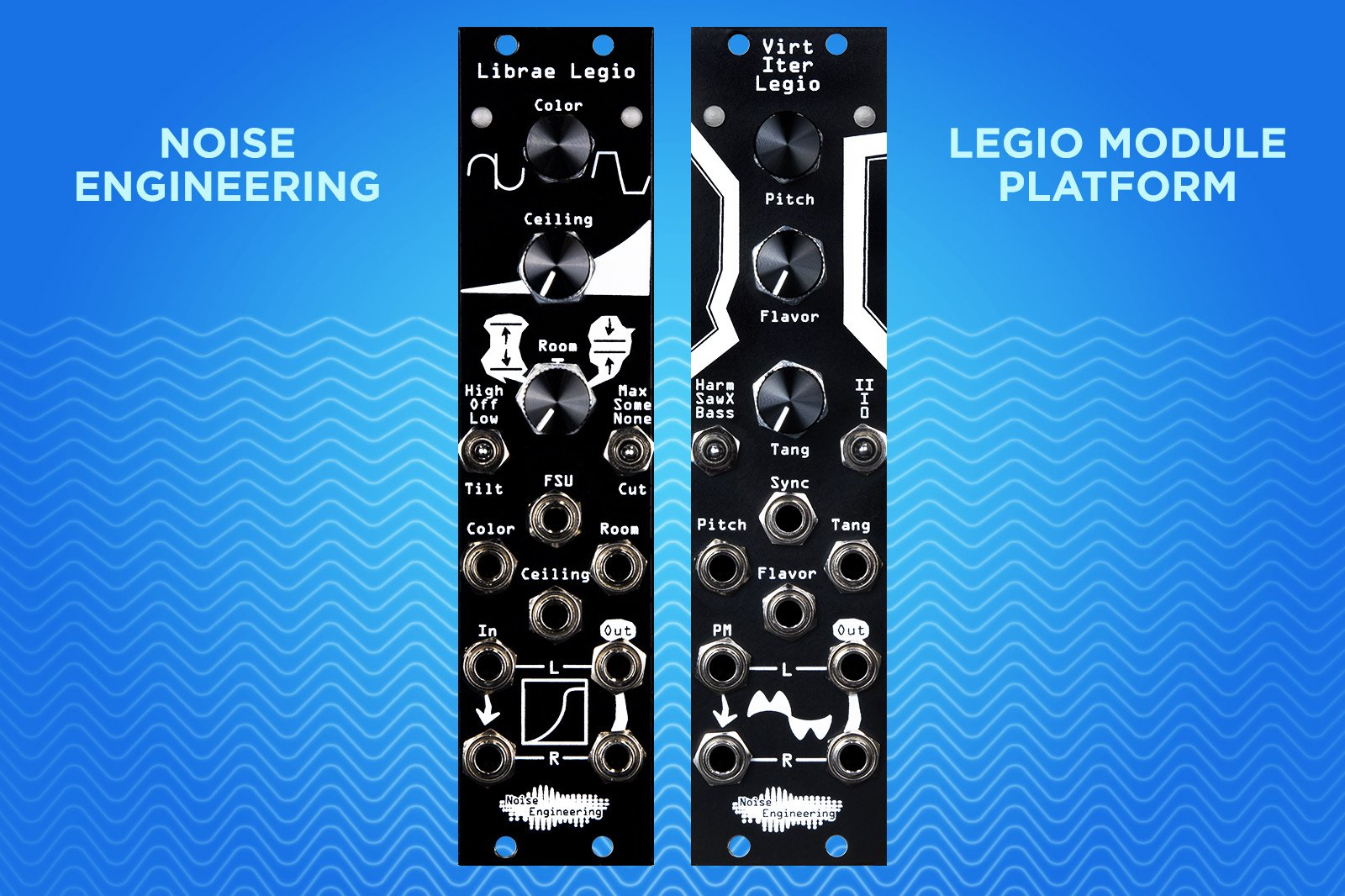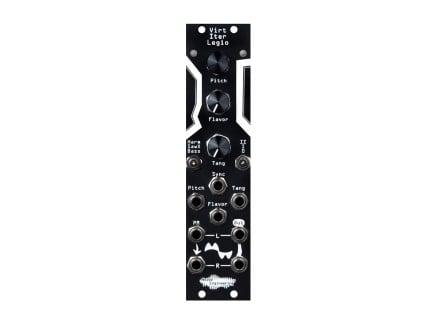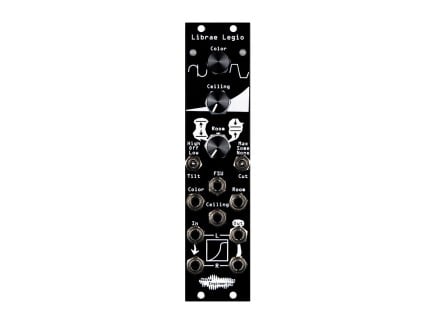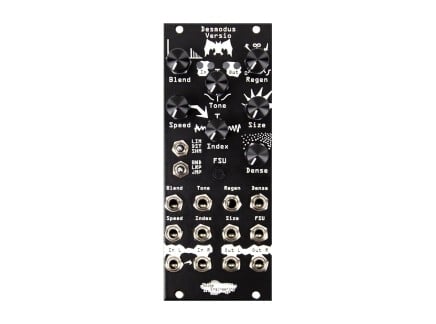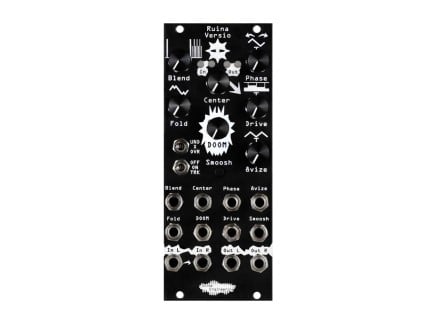Today, Noise Engineering has introduced not one, but two new modules: the Virt Iter Legio and Librae Legio. And not only do these modules respectively represent some striking new ideas in oscillator design and dynamic processing—they're also the first modules to use Noise Engineering's new module "platform" Legio, which promises to provide a form for many new creations going forward.
Let's talk a bit about what led up to these particular modules, and then discuss what each of these new devices has to offer.
Building a Platform
The Legio platform isn't Noise Engineering's first general-purpose module-development platform. Long-time modular fans will, of course, note Noise Engineering's long-standing practice of building modules with strikingly similar (if not identical) user interfaces. This can be traced back to designs like the Zularic Repetitor and Numeric Repetitor, or to the Basimilus Iteritas Alter, Manis Iteritas, Cursus Iteritas, and Ataraxic Iteritas—all of which perform similar functions to the other members of their own design "families."
Of course, more recently we've seen this idea taken to the extreme. Noise Engineering's embrace of the stunningly powerful Electrosmith Daisy platform and deepening of their own tendency to iterate on similar hardware designs led us to the Versio series.
The Versio series are a unique case, offering a fresh take on multi-effects: instead of having every effect available all at once, you can change the entire purpose of the module to do one thing really well. So while there are now a number of Versio modules available (including the quite popular Desmodus Versio reverb and Imitor Versio delay), on a hardware level they're all actually exactly the same. The only difference is the firmware, which can easily be swapped by end-users via USB connection. This means that Noise Engineering have been able to develop an astonishing number of unique effect modules in the last few years: each new design is just a matter of creating new code and new panel graphics. That's pretty rad.
Using the same type of mindset, Noise Engineering now brings us a similar idea in a smaller package with the Legio lineup. The initial offering gives us two modules at just 6hp apiece. Like the Versio series, Legio modules are built using the Daisy platform meaning you can easily swap firmware between all Legio designs. And for that matter, the industrious can even program their own custom firmwares…but let's avoid that particular rabbit hole for the moment, and instead turn our focus to the first members of the Legio family.
Stereo Multi-Mode Oscillator: Virt Iter Legio
The first module we'll look at is the Virt Iter Legio, which is a stereo oscillator that features three algorithms. Virt Iter was first introduced at NAMM 2020, and has since remained at #workinonit status—so we're thrilled to see it finally emerging after years of development. Virt Iter promised to be the debut of Noise Engineering's new oscillator platform, though as we'll see, there's more to the Legio family than oscillation alone.
Using a synthesis structure found in Noise Engineering's own VST plugins and in their contributions to the Arturia MicroFreak, the Virt Iter Legio can create a wide array of interesting and unique sounds. SawX mode provides glistening, noisy, super-sawlike sonic animations and pseudo-multi-oscillator tones ranging from glasslike harmonies to abrasive clangs; Harm mode offers peculiar harmonic accentuations; and the Bass algorithm provides noisy, saturated, gnarly folded synth tones and snarls.
With only three main controls for Pitch, Flavor, and Tang, you can easily get your perfect sound quickly—with the Flavor and Tang parameters changing function based on the selected algorithm. Two dedicated stereo phase modulation inputs aid in creating massive, wide sounds, and with a built-in vintage-inspired chorus, you can take quick command of the stereo field. Like on their other designs, the Legio series is rife with CV inputs. Virt Iter Legio features CV inputs for each of the three main controls and a hard Sync input.
Flexible Dynamic Processing: Librae Legio
Maybe you have all the oscillators you need—and if so, the Librae Legio might be something worth looking at.
Librae Legio is a stereo dynamics processor that can hug your sounds together when working as a compressor or limiter, but it can also distort and mangle your sounds when using the optional saturation stage. A built-in noise gate will let you filter out any unwanted signal chain noise that might appear after you squash your patch. With variable controls for Color, Ceiling, and Room (with dedicated CV inputs), you have easy access to a wide range of dynamic processes.
And then, sometimes you want to go extreme. And that is exactly what the FSU input is there for: patch a gate into that puppy and it will max out everything, leaving you with a blown-out, distorted mess of sonic chaos.
No matter the situation, having a dynamics processor will make your signal sound more cohesive—plus you won't have to worry about adding an extra piece of gear or plugin to your modular track.
New Platform, New You
As with the Versio series, Noise Engineering are going to continue to develop and expand the Legio lineup of modules. And again, as with the Versios, this means that if you buy one, you have them all.
As with all Noise Engineering products, you can expect exceptional support, high-quality audio, and a commitment to sonic exploration—and of course, a tendency to seriously FSU.

